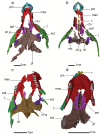Palate evolution in early-branching crocodylomorphs: Implications for homology, systematics, and ecomorphology
- PMID: 35595547
- PMCID: PMC9543995
- DOI: 10.1002/ar.24993
Palate evolution in early-branching crocodylomorphs: Implications for homology, systematics, and ecomorphology
Abstract
Living crocodylomorphs have an ossified secondary palate with a posteriorly positioned choana that enables their semi-aquatic, predatory ecology. In contrast, the earliest branching members of Crocodylomorpha have an open palate with anteriorly positioned choanae. The evolution of an ossified secondary palate and a posteriorly positioned choana features strongly in hypotheses of broad-scale phylogenetic relationships within Crocodylomorpha. Renewed investigations into palatal morphology among extinct members of the clade show surprising variability in the anatomy of the palate, with at least one and potentially a second independent occurrence of "eusuchian-type" palate outside of Eusuchia. Understanding the trajectory of crocodylomorph palatal evolution is, therefore, a key to inferring crocodylomorph interrelationships and ecomorphology. To document early-branching crocodylomorph palatal anatomy, we developed an anatomical comparative dataset using computed tomography scan data and literature, comprising 12 early-branching crocodylomorph taxa. To understand discrete phenotypic changes in palatal structure, we compiled a phylogenetically broadly sampled character-taxon matrix from the existing literature, and revised its palatal characters, adding 10 new palatal characters. Our comparative anatomical investigations allow us to propose an adapted hypothesis for the closure of the palate and the posterior migration of the choana. Our phylogenetic findings corroborate previous research showing that non-crocodyliform crocodylomorphs ("sphenosuchians") are paraphyletic, with the exclusion of the clade Hallopodidae. Non-mesoeucrocodylian crocodyliforms ("protosuchians") are paraphyletic, but form three monophyletic clades: Notochampsoidea, Shartegosuchoidea, and Gobiosuchidae. We find a potential association between secondary palate development and dietary shifts, particularly with regard to hypothesized origins of herbivory.
Keywords: crocodylian; phylogenetics; secondary palate.
© 2022 The Authors. The Anatomical Record published by Wiley Periodicals LLC on behalf of American Association for Anatomy.
Figures






Similar articles
-
Braincase anatomy of Almadasuchus figarii (Archosauria, Crocodylomorpha) and a review of the cranial pneumaticity in the origins of Crocodylomorpha.J Anat. 2020 Jul;237(1):48-73. doi: 10.1111/joa.13171. Epub 2020 Mar 30. J Anat. 2020. PMID: 32227598 Free PMC article.
-
Reevaluation of the cranial osteology and phylogenetic position of the early crocodyliform Eopneumatosuchus colberti, with an emphasis on its endocranial anatomy.Anat Rec (Hoboken). 2022 Oct;305(10):2557-2582. doi: 10.1002/ar.24777. Epub 2021 Oct 22. Anat Rec (Hoboken). 2022. PMID: 34679248
-
The multi-peak adaptive landscape of crocodylomorph body size evolution.BMC Evol Biol. 2019 Aug 7;19(1):167. doi: 10.1186/s12862-019-1466-4. BMC Evol Biol. 2019. PMID: 31390981 Free PMC article.
-
A new fossil from the Jurassic of Patagonia reveals the early basicranial evolution and the origins of Crocodyliformes.Biol Rev Camb Philos Soc. 2013 Nov;88(4):862-72. doi: 10.1111/brv.12030. Epub 2013 Feb 28. Biol Rev Camb Philos Soc. 2013. PMID: 23445256 Review.
-
A review of the non-semiaquatic adaptations of extinct crocodylomorphs throughout their fossil record.Anat Rec (Hoboken). 2025 Feb;308(2):266-314. doi: 10.1002/ar.25586. Epub 2024 Nov 25. Anat Rec (Hoboken). 2025. PMID: 39587416 Review.
Cited by
-
Evidence for a novel cranial thermoregulatory pathway in thalattosuchian crocodylomorphs.PeerJ. 2023 May 2;11:e15353. doi: 10.7717/peerj.15353. eCollection 2023. PeerJ. 2023. PMID: 37151298 Free PMC article.
-
Unique trackway on Permian Karoo shoreline provides evidence of temnospondyl locomotory behaviour.PLoS One. 2023 Mar 29;18(3):e0282354. doi: 10.1371/journal.pone.0282354. eCollection 2023. PLoS One. 2023. PMID: 36989249 Free PMC article.
-
Skull sinuses precluded extinct crocodile relatives from cetacean-style deep diving as they transitioned from land to sea.R Soc Open Sci. 2024 Oct 30;11(10):241272. doi: 10.1098/rsos.241272. eCollection 2024 Oct. R Soc Open Sci. 2024. PMID: 39479241 Free PMC article.
-
Size, not phylogeny, explains the morphology of the endosseous labyrinth in the crown clade Crocodylia.J Anat. 2025 Apr;246(4):558-574. doi: 10.1111/joa.14170. Epub 2024 Dec 20. J Anat. 2025. PMID: 39707154 Free PMC article.
-
The velar chord and dynamic integration of the gular valve in crocodylians.Anat Rec (Hoboken). 2025 Aug;308(8):2234-2249. doi: 10.1002/ar.25608. Epub 2024 Dec 5. Anat Rec (Hoboken). 2025. PMID: 39635754 Free PMC article.
References
-
- Andrade, M. , Bertini, R. , & Pinheiro, A. (2006). Observations on the palate and choanae structures in mesoeucrocodylia (Archosauria, Crocodylomorpha): Phylogenetic implications. Revista Brasileria de Paleontologia, 9, 323–332.
-
- Barrios, F. , Bona, P. , Paulina‐Carabajal, A. , & Gasparini, Z. (2018). Re‐description of the cranio‐mandibular anatomy of Notosuchus terrestris (Crocodyliformes, mesoeucrocodylia) from the upper cretaceous of Patagonia. Cretaceous Research, 83, 3–39.
-
- Busbey, A. B. (1995). The structural consequences of skull flattening in crocodilians. In Thomason J. J. (Ed.), Functional morphology in vertebrate paleontology (pp. 173–192). Cambridge Press.
-
- Butler, R. , Barrett, P. , Kenrick, P. , & Penn, M. (2009). Diversity patterns amongst herbivorous dinosaurs and plants during the cretaceous: Implications for hypotheses of dinosaur/angiosperm co‐evolution. Journal of Evolutionary Biology, 22, 446–459. - PubMed
-
- Clark, J. M. (1994). Patterns of evolution in Mesozoic Crocodyliformes. In Fraser N. C. & Sues H. (Eds.), In the shadow of dinosaurs (pp. 84–97). Cambridge University Press.
Publication types
MeSH terms
LinkOut - more resources
Full Text Sources

